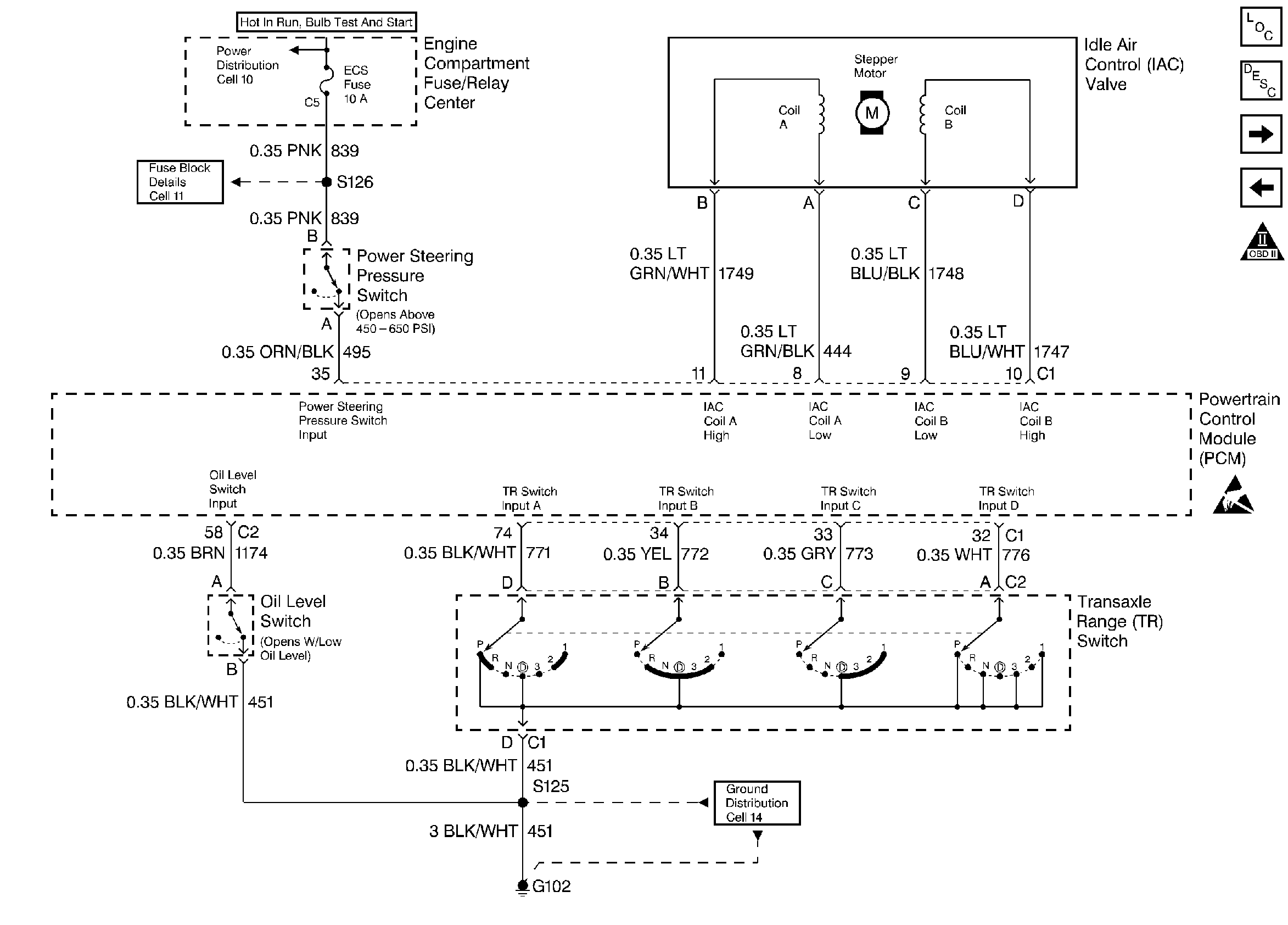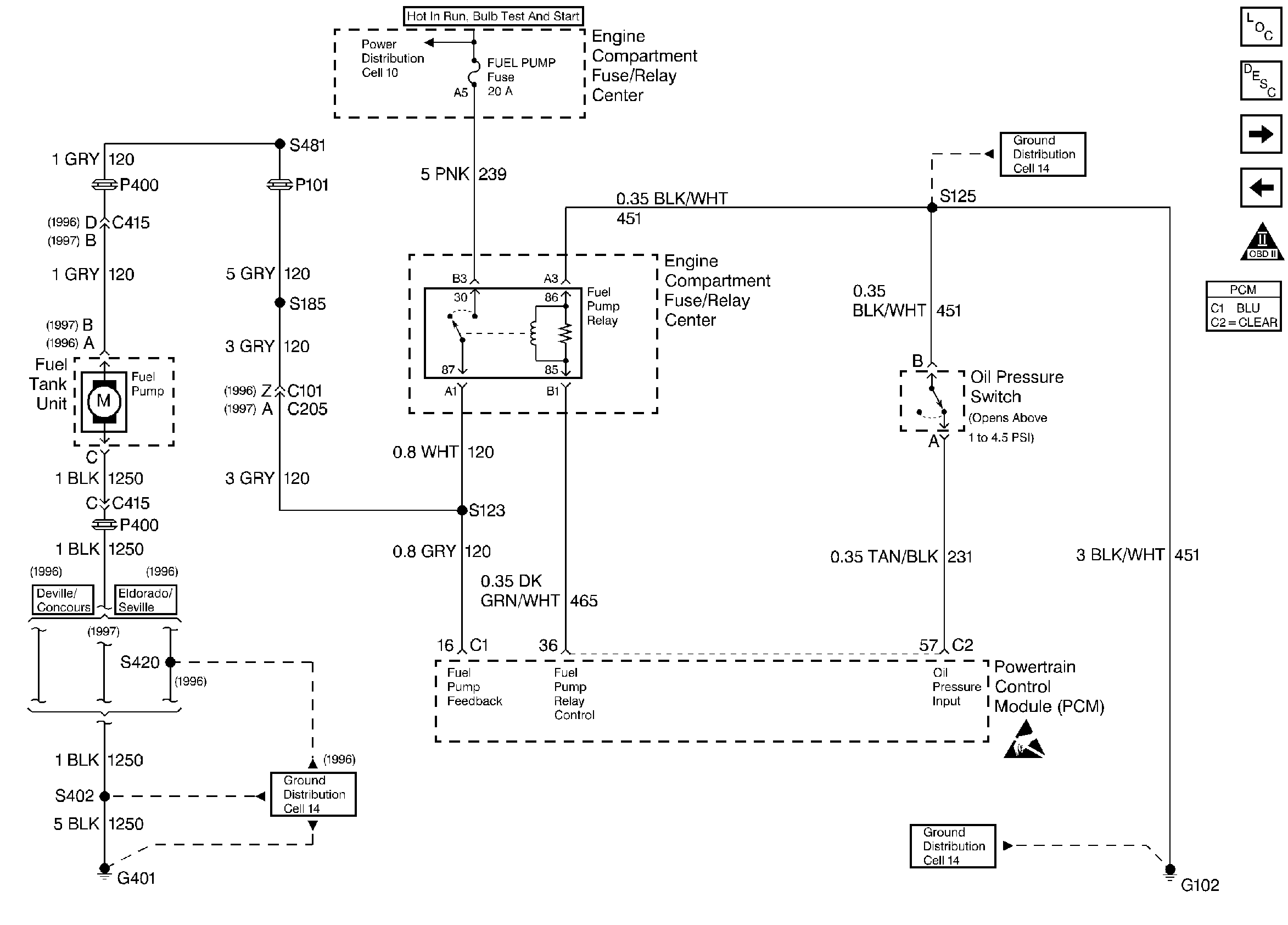PCM Message Diagnosis Low Engine Oil Level Message
Refer to
IAC Valve and PSP/ Oil Level/ TR Switches

for wiring view.
Circuit Description
The oil level switch is a magnetic reed float style switch which is closed with oil level full and open when oil level is low. The PCM monitors the oil level switch to determine if the oil is LOW or OK. When the Test Conditions have been met the PCM will monitor the oil level switch input. If a low oil level is indicated the PCM will send a serial data message to the Driver Information center (DIC). The DIC will then indicate the oil level is low. If the Test Conditions have not been met then the PCM ignores the oil level switch input and oil level OK is indicated to the DIC. The engine coolant temperature Test Condition is required to ensure enough time has passed since the engine was last stopped. The time period/coolant temperature difference is to allow enough time for the engine oil to drain back into the oil pan. The colder the current engine temperature is, the larger the drop in temperature necessary. This is to ensure colder, thicker oil has drained back into the oil pan.
Test Conditions
| • | DTC's P0117, P0118 or P0603 not set. |
| • | Engine speed is 0 RPM. |
| • | The current engine coolant temperature is from 5°C to 20°C less than the temperature stored when the engine was last running. |
Important: The oil level switch is mounted to the oil pan at a level below the full level. Removal of the switch may drain several quarts of oil.
Test Description
-
The Powertrain OBD System Check must be performed before proceeding with this diagnosis. Go to any DTC's that are set first.
-
With the engine speed at or above 2300 RPM the engine oil switch should indicate LOW oil level. The engine oil is scavenged to a level that is below the switch during higher engine speed and also during some lateral vehicle movement conditions.
Step | Action | Value(s) | Yes | No |
|---|---|---|---|---|
1 | Was the Powertrain On-Board Diagnostic (OBD) System Check performed? | -- | Go to Powertrain OBD System Check | |
2 |
Fill or drain the engine oil if required. Does the display indicate the oil level is OK? | -- | ||
3 |
Does the engine oil level display indicate LOW while engine speed is at the specified value? | 2300 RPM | Fault not present. Refer to Diagnostic Aids | |
4 |
Does the engine oil level display indicate the oil level is OK? | -- | ||
5 | Place the jumper between terminal A and a known good engine ground. Does the display indicate the engine oil is OK ? | -- | ||
6 |
Is the resistance the same or less than the value specified? | 5 ohms | ||
7 |
Does the engine oil level display indicate the oil level is LOW? | -- | ||
8 |
Is the resistance the same or more than the value specified? | 10K ohms | ||
9 | Repair the open in the engine oil level input circuit. Is the repair complete? | -- | Go to Powertrain Control Module Diagnosis for Verify Repair | -- |
10 | Repair the open in the engine oil level switch ground circuit. Is the repair complete? | -- | Go to Powertrain Control Module Diagnosis for Verify Repair | -- |
11 | Repair the short to ground in the engine oil level switch input circuit. Is the repair complete? | -- | Go to Powertrain Control Module Diagnosis for Verify Repair | -- |
12 |
Was the terminal contact repaired? | -- | Go to Powertrain Control Module Diagnosis for Verify Repair | |
13 | Replace the engine oil level switch. Is the replacement complete? | -- | Go to Powertrain Control Module Diagnosis for Verify Repair | -- |
14 |
Was terminal contact repaired? | -- | Go to Powertrain Control Module Diagnosis for Verify Repair | |
15 | Replace the Powertrain Control Module. Refer to PCM Replacement/Programming . Is the replacement complete? | -- | Go to Powertrain Control Module Diagnosis for Verify Repair | -- |
PCM Message Diagnosis Low Oil Pressure Message
Refer to
Fuel Pump and Relay

for
wiring view.
Circuit Description
The engine oil pressure switch is normally closed. When engine oil pressure increases above 1 to 4.5 psi the switch contacts open. The PCM supplies 12 volts to the oil pressure input circuit. With low oil pressure the 12 volts is pulled low to ground.
When the PCM monitors a low oil pressure condition the PCM will command a message be displayed on the Driver Information Center. The PCM will also increase the Desired Idle engine speed in an attempt to raise engine oil pressure.
Message Conditions
| • | Engine speed is more than 57 RPM for 4 seconds. |
| • | The engine oil pressure switch indicates low oil pressure for 4.2 seconds. |
The Message is cleared when the engine oil pressure switch indicates oil pressure or when engine speed is 0 RPM.
Idle Speed Increase Conditions
| • | Engine speed is more than 400 RPM for 3 seconds. |
| • | The engine oil pressure switch indicates low oil pressure for 3 seconds. |
The Desired Idle speed is commanded to a mininum engine speed of 744 RPM.
Desired Idle is returned to normal PCM control when the engine oil pressure switch indicates oil pressure or when engine speed is 0 RPM.
Test Description
-
If the Oil Pressure parameter indicates OK when disconnected measure the engine oil pressure with a mechanical gauge. Refer to Engine Mechanical . Ensure that engine oil pressure is within operating specifications before replacing the Engine Oil Pressure Switch.
-
If the fuse in the jumper opens when probing the circuit repair the short to voltage on the oil pressure input circuit.
Step | Action | Value(s) | Yes | No |
|---|---|---|---|---|
1 | Was the Powertrain On-Board Diagnostic (OBD) System Check performed? | -- | Go to A Powertrain On Board Diagnostic (OBD) System Check | |
2 |
Does the Oil Pressure status indicate LOW pressure? | -- | ||
3 | Start and idle the engine. Does the Oil Pressure status indicate oil pressure is OK? | -- | System OK | |
Does the Oil Pressure status indicate oil pressure is OK? | -- | |||
5 |
Is the resistance the same or more than the value specified? | 10K ohms | ||
Does the Oil Pressure status indicate LOW pressure? | -- | |||
7 |
Does the Oil Pressure status indicate LOW pressure? | -- | ||
8 |
Is the voltage the within a half volt of the value specified? | B+ | ||
9 |
Is the voltage more than the value specified? | 0.5 volts | ||
10 |
Is the resistance the same or less than the value specified? | 5 ohms | ||
11 | Repair the short to ground on the oil pressure input circuit. Is the repair complete? | -- | Go to Powertrain Control Module Diagnosis for Verify Repair | -- |
12 | Repair the open in the oil pressure switch ground circuit. Is the repair complete? | -- | Go to Powertrain Control Module Diagnosis for Verify Repair | -- |
13 | Repair the short to voltage on the oil pressure input circuit. Is the repair complete? | -- | Go to Powertrain Control Module Diagnosis for Verify Repair | -- |
14 | Repair the open in the oil pressure input circuit. Is the repair complete? | -- | Go to Powertrain Control Module Diagnosis for Verify Repair | -- |
15 |
Was terminal contact repaired? | -- | Go to Powertrain Control Module Diagnosis for Verify Repair | |
16 | Replace the Engine Oil Pressure Switch. Refer to Engine Mechanical . Is the replacement complete? | -- | Go to Powertrain Control Module Diagnosis for Verify Repair | -- |
17 |
Was terminal contact repaired? | -- | Go to Powertrain Control Module Diagnosis for Verify Repair | |
18 | Replace the PCM. Refer to PCM Replacement/Programming . Is the replacement complete? | -- | Go to Powertrain Control Module Diagnosis for Verify Repair | -- |
